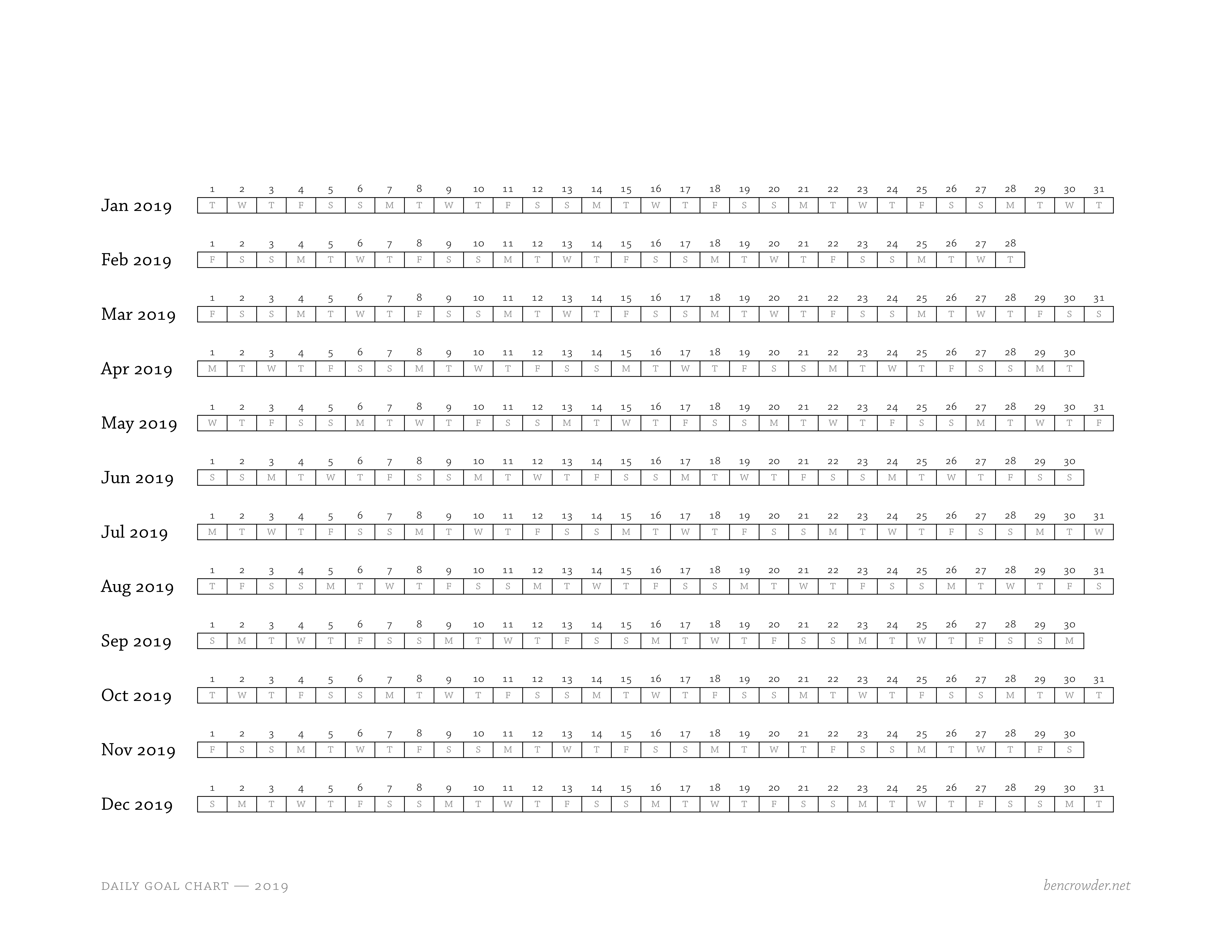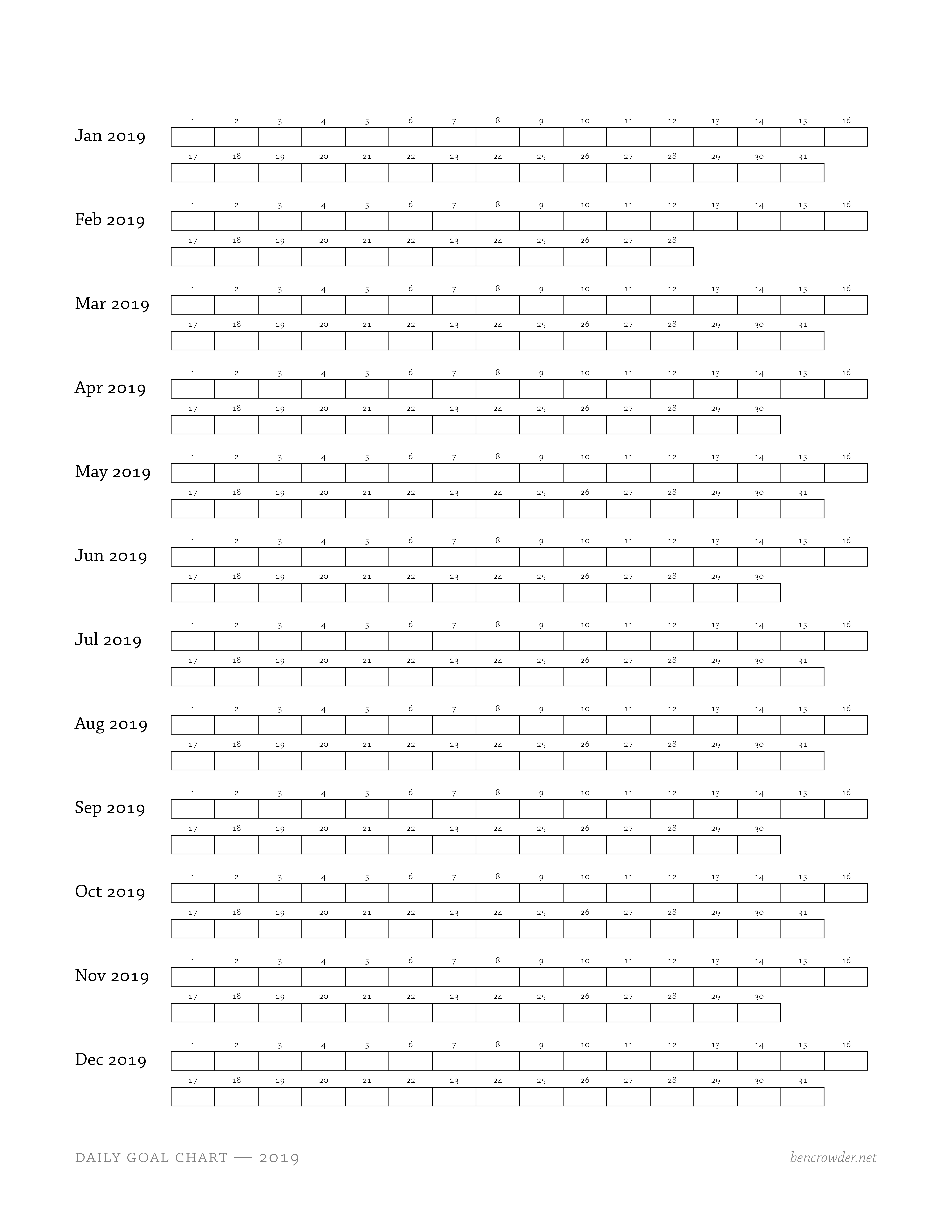Earth Below
Four years later, I’ve finally finished a new story: Earth Below. It’s science fiction. The making-of notes will be in the next Manmade newsletter. (Seems like a natural place to put those.)
Four years later, I’ve finally finished a new story: Earth Below. It’s science fiction. The making-of notes will be in the next Manmade newsletter. (Seems like a natural place to put those.)
The only time I’ve had success writing each day has been when I’ve made a physical chart, taped it up on my wall, and then filled in a box each day I hit my goal. It’s Jerry Seinfeld’s don’t break the chain idea, and it works remarkably well for me. My current streak (I don’t write on Sundays):

Since this seemed like it might be useful for others, I’ve made daily goal charts, available for free PDF download:

There’s also what I’m calling a “blank” chart, where you can write in the number of words you wrote (or anything else like that):

Charts for 2018 through 2023 are up. (I figure five years is enough for now.)
Update on projects: I’m working on a short story. All of my story drafts of late have turned darker than I’d like, so this one is intentionally not dark. Seems to be going better than the others.
I’m also partway through revising my next picture book. This one is a story (as opposed to The Circle Book, which was just a list of random things) and I’m excited. The urge to design a typeface for it has proven too strong to resist, though, so I’m working on that as well. The typeface is called Golly. I’ll post some screenshots soon (I’m almost done with the lowercase letters).
Sidenote on type design: I built Curves (a Python library for designing type, via exporting to UFO and compiling that to OTF) to see whether designing type in code works. Turns out it doesn’t. Even with easy previews (SVG and @font-face), the cognitive gap between the code and the points seems to be a little too much. I have some other ideas for type design tools that seem more promising, though. More on that later.
And I’m slowly working on the remaining reader’s editions (print/PDF of D&C, Pearl of Great Price, and Words of the Prophets).
Ursula K. Le Guin in Words Are My Matter:
Present-tense narration is now taken for granted by many by many fiction readers because everything they read, from internet news to texting, is in the present tense, but at this great length it can be hard going. Past-tense narration easily implies previous times and extends into the vast misty reaches of the subjunctive, the conditional, the future; but the pretense of a continuous eyewitness account admits little relativity of times, little connection between events. The present tense is a narrow-beam flashlight in the dark, limiting the view to the next step — now, now, now. No past, no future. The world of the infant, of the animal, perhaps of the immortal.
I don’t at all mind present tense, but she does have a point.
Michael Swanwick on how fantasy is not about magic:
So what is the beating heart of fantasy, its sine qua non, its irreducible necessity?
Enchantment.
I’ve learned lately that I quickly lose interest in the fiction I’m writing unless it has the following:
These aren’t massive, groundbreaking revelations, of course, but I’d somehow lost sight of them over the years or wasn’t fully aware of them before. Now that I’ve tugged them back into my conscious mind, though, I’m ready to start finishing stories again.
A quick update: I was stuck for a while on the Dagh story, but I’ve started spending my lunch hour working on it, and it’s coming together nicely. I should have a complete first draft done soon. (I’ve got 7,000 words on it so far.)
I’ve spent the last few months avoiding the heck out of writing the novel (Edge of Magic). The plot changed several times — completely changed, that is — and then I abandoned it and started on a short story which I then also abandoned.
The good news, however, is that I’ve written a thousand words a day every day solid since the beginning of December. The habit is securely in place.
Tonight I realized that for some reason, when I’m working on a story I can’t do other projects at the same time (art, typesetting, coding, etc.). Whether it’s because I use those other projects as avoidance or something else, I don’t know. But during a writing project — at least the planning stage, not sure yet whether it applies to the drafting stage — I need to put all my other projects on the back burner. That gives me enough mental space to let the story grow.
The plan right now: finish the aforementioned short story (featuring Dagh and María Bonita — I don’t have a title yet), then decide which novel I’m actually going to write, outline it, and write it as fast as I can, to get it done before self-doubt slashes my tires.
One problem with the novel, by the way, was that Makrannan’s character was never very clear or interesting to me. He never came alive to me. Thus his part of the book was always weak, even after several re-outlinings. With this current story, however, Dagh and María Bonita feel much more alive to me, and it’s making all the difference. (And hopefully that will make the story much more worth reading than my earlier stories.)
Goal: finish the first draft of the Dagh story by May 21, and release the edited story on my site by May 31.
To help me with my thousand-words-a-day goal, I’ve been using a tool I wrote called Speed. It’s a desktop app, written using Electron, and it looks like this:


As you can see, it’s fairly simple. The code is on GitHub.
Back on December 3, I made a goal to write a thousand words of fiction a day, every day (skipping Sundays). I made up a chart with sixteen weeks on it, ending March 19, printed it out, and taped it on the headboard of our bed.
And that chart is now full. I’ve written exactly 100,000 words since December 3 (I wrote a little extra each day), which is crazy considering that I used to be unable to get myself to write at all. I don’t know what actually made the change, but I’m writing every day and it’s great.